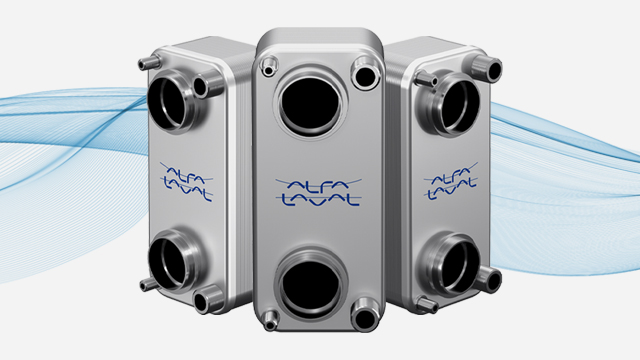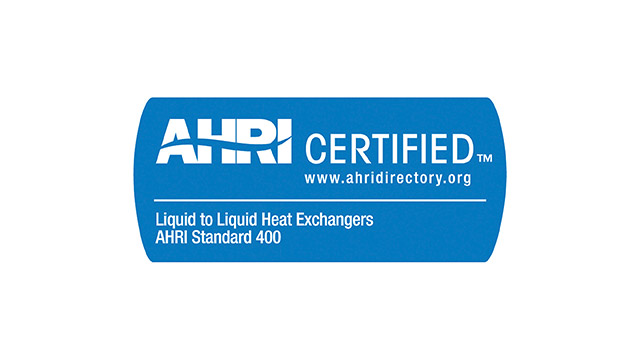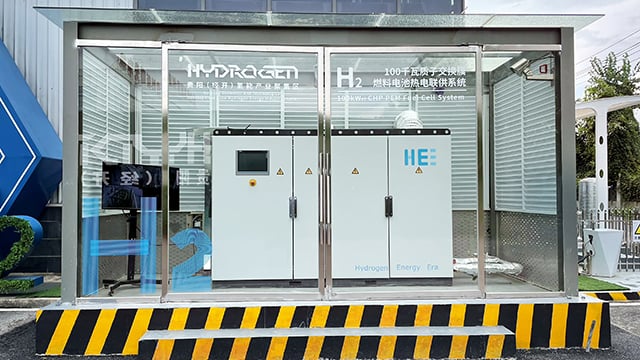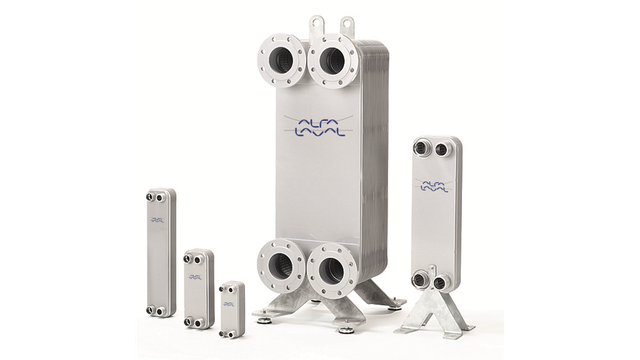AlfaNova
AlfaNovaは、アルファ・ラバルの特許取得済みのAlfaFusionテクノロジーを使用して製造された熱交換器で、波形の付いたステンレス鋼のプレートが銅やニッケルを使用せずに接合されています。ユニークなデザインにより、AlfaNovaは従来のブレーズドプレート熱交換器よりもより極端な温度と圧力に耐え、疲労に対する抵抗力も高いです。また、非常に高い衛生要求を必要とする用途にも適しています。
AlfaNovaについて
- タップウォーターシステムなどの衛生的なアプリケーションに最適な解決策です。
- 銅フリーの設計は、アンモニア冷媒を使用する場合や清浄な水の冷却シリンダーのアプリケーションに適しています。
- 多くの接触点に負荷を分散することで、優れた圧力疲労耐性を確保します。
- AHRI認証を取得しており、さまざまな空調管理アプリケーションで信頼性のある熱性能を提供します。
- 広い温度範囲と銅フリーの構造により、さまざまなLPG/LNG業務に使用するための船級仕様が利用可能です。
AlfaNovaの独自のフュージョンボンデッド製造プロセスは、プレートパックにより大きな補強を提供し、同等の技術よりも高い圧力耐性を確保します。さらに、100%ステンレス鋼の構造により、最大550°C(1020°F)の高温に耐えることが可能です。その結果、AlfaNovaのフュージョンボンデッドプレート熱交換器は、極端な圧力および温度要件があるアプリケーションにおいて非常に信頼性が高いです。また、すべての主要部品に同じ材料を使用することは、高い熱効率を提供するだけでなく、溶接された相当する機械的強度をもたらします。
AlfaNovaは、アルファ・ラバルが特許を取得した画期的な技術を駆使して溶融接合した100%ステンレス製のプレート式熱交換器です。AlfaNovaは、他のブレージングプレート式熱交換器よりも優れた衛生性および耐食性を提供します。ステンレス製プレート式熱交換器はこれまで、半溶接型および全溶接型の製品のみでしたが、溶融接合技術により、密閉型のステンレス製プレート式熱交換器の実用化に成功したものです。
AlfaNovaにより、従来のブレージングプレート式熱交換器では破損の可能性のある超高温条件や圧力変動のある条件下でも、高効率で使用することが可能となりました。AlfaNovaはガスケットを使用しない画期的な熱交換器ですので、腐食性のある流体や高温下でも少ない稼動コストを実現でき、幅広い用途に使用可能です。100%ステンレスの構造は、最高550℃の高温に耐えることができます。
アルファ・ラバルは、安全性、信頼性および耐久性を保証するために、AlfaNovaの圧力疲労、熱疲労、伝熱性能および耐食性の徹底的な検証を行いました。この画期的な設計による多くのメリットや信頼性により、AlfaNovaは幅広い用途に対応でき、優れた経済性のある熱交換ソリューションとなりました。例えば、アンモニアなどの冷媒を使用する冷却システムや腐食性のある水を用いる地域暖房設備において、AlfaNovaの設計が広く受け入れられています。
また、優れた衛生性と機械的強度を併せ持つAlfaNovaは、純水冷却器(清水チラー)および給湯システムのような、衛生に重点を置いた用途にも最適です。
新しい AlfaNova GL50
GL50は100%ステンレス鋼製の非対称型ガスから液体へのプレート熱交換器です。片手で持つことができるほど小さいですが、250立方メートル/時のガス流量や最大750°Cの入口ガス温度にも対応し、優れた性能を発揮します。

HVAC用のAHRI認証
AlfaNova熱交換器は、エアコンディショニング、暖房、冷凍協会(AHRI)の液体対液体ブレーズドおよびフュージョンボンド熱交換器プログラムに基づく認証を取得しています。HVACアプリケーションで使用される熱交換器に対して、このプログラムはメーカーの公表された仕様に基づいた熱性能の独立した第三者による検証を提供しています。

How it works
異なる温度を持つ2つの媒体が、互いに重ねられた薄い波形の付いたステンレス鋼のプレートの両側を流れます。2つの媒体は互いに逆向きの流れで、交互のチャネルを通って流れ、プレートパック内にはプレートの周囲にフュージョンボンデッドシールがあります。プレート同士が接触するポイントも同じ技術で結合されており、内部の媒体の圧力に対してパックを補強しています。
対流流動は、熱交換器内の熱源と冷却媒体の温度差が非常に小さい場合でも、効率的な熱の抽出が可能になります。これにより、顕著なエネルギーコストの節約が実現します。一部のシステムでは、同流流動も可能です。
アニメーションをご覧いただくことで、詳細をより深く理解できます。
パフォーマンス向上のためのユニークな特徴
アルファ・ラバルは熱伝達の革新において80年以上の経験を持ち、あらゆるアプリケーションに対して高性能なソリューションを提供するために必要な要素を理解しています。当社の専門家は常に新しいイノベーションを開発し、AlfaNova シリーズのフュージョンボンデッドプレート熱交換器により信頼性と効率性を高めるための取り組みを行っています。
PressureSecure
様々な環境に対応する高い強度
革新的なプレート設計で、高温・高圧の幅広い用途に対応します。より薄いプレートとより少ないプレートでユニットを稼働させることで、原材料の節約、エネルギー消費の削減、冷媒チャージの削減、機器のライフサイクルの延長につながります。
FlexFlow™
優れた伝熱性能
アルファ・ラバルの特許取得済み非対称プレート設計は、最適化された圧力損失と乱流の増加により熱効率を向上させる独自の技術革新の1つです。エネルギー消費量の削減に加えて、冷媒の量や原材料の削減にもつながります。
AlfaNova®
オールステンレス製の熱交換器
オールステンレス鋼製のAlfaNova®は、従来の熱交換器材料と互換性のない媒体に対応するソリューションです。高度設計で自然冷媒での使用に最適化されているだけでなく、完全にリサイクル可能です。
アルファ・ラバルのプレート熱交換器を使用して構築された燃料電池システムは、持続可能で安全性が高く、コスト効率が良いです
ドイツの再生可能エネルギー供給業者であるHEE Technologies GmbHがコジェネレーション(CHP)燃料電池システムを設計する際、燃料電池スタックの冷却や排気熱の回収にアルファラバルのプレート熱交換器を使用することは明確な選択でした。このシステムは水素をエネルギー源として使用しており、持続可能性が高く、安全で、かつコスト効率が良いです。

用途に合った熱交換器を探す
アルファ・ラバルは数十年にわたる熱交換の経験を通じて培った専門知識を活かし、現在の暖房や冷却の課題に対処するためのガイダンスと有用なツールを提供しています。当社の製品ガイドは、あなたのアプリケーションに最適なソリューションを見つけるために利用できるインタラクティブなリソースです。

Contact us
私たちのブレージング プレート熱交換器やフュージョンボンデッドプレート熱交換器のポートフォリオについてご質問はありますか?ご要件に合った最適なモデルを見つけるために、お手伝いさせていただけます。

